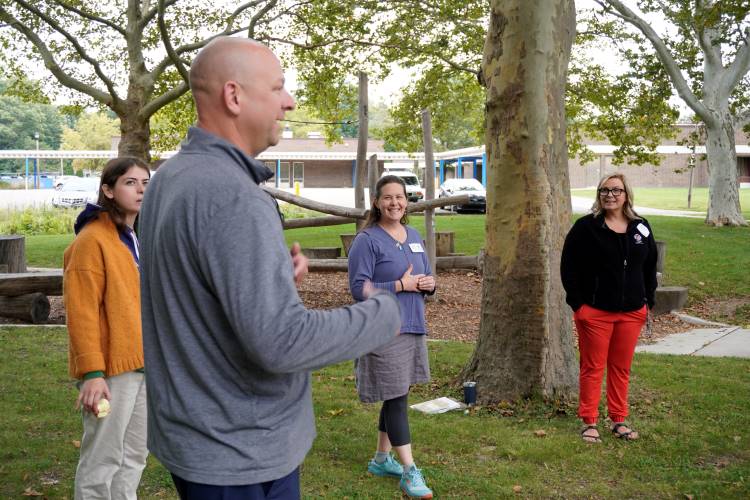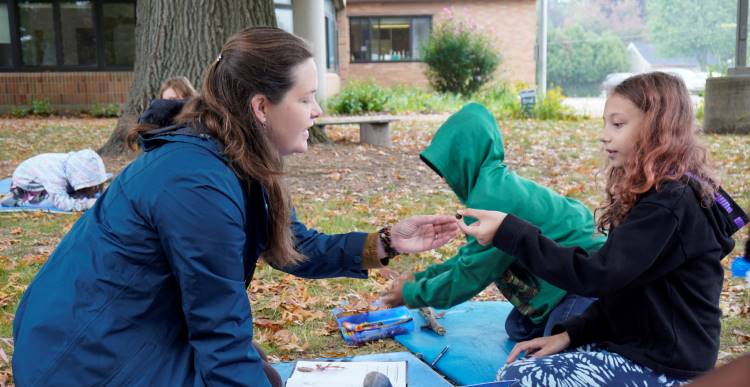Grand Rapids — Kindergartner Alaya Jackson had to take a minute to consider her favorite thing to draw in her nature journal before deciding on an answer: leaves.
“They’ve got different colors,” she said exuberantly, holding up a freshly fallen leaf. “Lookit!”
Classmate Keiven Flakes was just as excited about the activity as he rattled off what he’d drawn at a breathless clip: “Rain and grass and a coconut tree, sky, some wind, and I also drew a cow. … And that’s some logs and this is a birdhouse and — I forgot what this was.”
Alaya, Keiven and the rest of Stephanie Nielsen’s kindergarten class at Shawmut Hills Elementary were in the midst of a phenology journaling session, buddying up with fourth-graders from Sarah Westman’s class to explore their outdoor surroundings.
Seated in their grassy “sit-spots” on one of the first chilly mornings of the fall, the kindergartners soaked up nature by drawing things they saw, smelled, heard and felt. The fourth-graders had more specific fields to fill out, like the time of day, the temperature, the location, the season, the phase of the moon and more.
Nature journaling is a prime example of how educators can implement outdoor learning into their daily routines, according to GRPS environmental education consultant Sally Triant.
‘GRPS has a mission and vision for environmental education for every scholar to have an environmental learning experience every year.’
— Environmental Education Consultant Sally Triant
Training Teachers
The activity applies concepts Triant discussed during a pair of recent teacher training sessions — one at Shawmut, the other at Ken-O-Sha Elementary — aiming to boost teachers’ confidence in educating outside the classroom, while also helping the district make progress toward achieving a long-standing goal.
“GRPS has a mission and vision for environmental education for every scholar to have an environmental learning experience every year, every grade, pre-K through 12th,” Triant said.

The district previously conducted a survey to determine the main barriers to outdoor education; at the top of the list were the need for outdoor teacher training, the lack of outdoor classroom space and the need for curriculum connections.
The Ken-O-Sha training session addressed those concerns, functioning as a professional development experience and encouraging teachers to make use of school grounds in their lessons, while showing them how nature journals can tie into classroom curriculum.
On hand to help was Ted Malefyt from Outdoor Discovery Center Network. The Holland-based organization works to advance outdoor education and conservation throughout west Michigan, and Malefyt, a former teacher, works on the education side.
“My role is to support schools and teachers wanting to do meaningful work beyond the classroom,” Malefyt said. “We partner with schools long term, doing the nitty-gritty of the work that’s required to confidently and safely have our kids engage in learning outside.”
Malefyt worked with teachers to build understanding of how nature journals can be used to promote literacy in the classroom, supplying handouts that included a variety of ideas for lesson plans and ways to tie outdoor lessons back into the classroom.
The presentation led to “some really insightful conversation” among staff in attendance, Triant said, and the naturescape play area at Ken-O-Sha Elementary was a perfect setting.

However, she added that every schoolyard in the district has the capacity to offer equally engaging environmental learning activities.
Hopes for the Future
Triant hopes more teachers will try out activities like the phenology journals used by Nielsen and Westman at Shawmut.
Nielsen is pleased with the results she’s seen since using more nature-focused lessons after tuning into one of Triant’s webinars a few years back.
“I think it’s really good for (students’) social-emotional health just to be outside,” she said. “It’s just good for them to get outside the four walls of the classroom.”
Westman is also a fan. She said her fourth-graders are learning a lot about the environment, the changing seasons and more, while acting as mentors to their kindergarten counterparts.
Triant’s goal is to continue to stoke that excitement about environmental learning in the district, and to “give teachers that nudge they might need to take scholars outside.”

Read more from Grand Rapids:
• New principal envisions ‘a bright future’ at his alma mater
• Parents, students revitalize C.A. Frost garden









